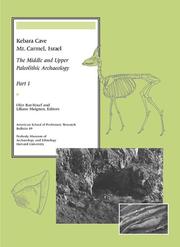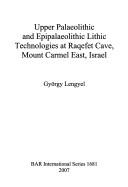| Listing 1 - 7 of 7 |
Sort by
|
Book

ISBN: 9781407303796 1407303791 Year: 2009 Volume: 1897 Publisher: Oxford Archaeopress
Abstract | Keywords | Export | Availability | Bookmark
 Loading...
Loading...Choose an application
- Reference Manager
- EndNote
- RefWorks (Direct export to RefWorks)
Excavations (Archaeology) --- Cities and towns, Ancient --- Fouilles (Archéologie) --- Villes antiques --- Carmel, Mount (Israel) --- Carmel, Mont (Israël) --- Antiquities. --- Antiquités --- Fouilles (Archéologie) --- Carmel, Mont (Israël) --- Antiquités
Book
ISBN: 9781905739875 1905739877 Year: 2014 Publisher: Oxford : Archaeopress Archaeology,
Abstract | Keywords | Export | Availability | Bookmark
 Loading...
Loading...Choose an application
- Reference Manager
- EndNote
- RefWorks (Direct export to RefWorks)
Excavations (Archaeology) --- Rural geography --- Fouilles (Archéologie) --- Géographie rurale --- History. --- Histoire --- Carmel, Mount (Israel) --- Carmel, Mont (Israël) --- Antiquities. --- Antiquités
Book
Year: 1998 Volume: 77 Publisher: Liège : Service de Préhistoire, Université de Liège,
Abstract | Keywords | Export | Availability | Bookmark
 Loading...
Loading...Choose an application
- Reference Manager
- EndNote
- RefWorks (Direct export to RefWorks)
Natufian culture --- Mesolithic period --- Excavations (Archaeology) --- Natufien --- Mésolithique --- Fouilles (Archéologie) --- Wad Cave (Israel) --- Carmel, Mount (Israel) --- Wad, Grotte d'El (Israël) --- Carmel, Mont (Israël) --- Antiquities. --- Antiquités
Book
Year: 1981 Volume: 10 Publisher: Paris : Muséum national d'histoire naturelle, Musée de l'homme, Laboratoire de paléontologie humaine et de préhistoire,
Abstract | Keywords | Export | Availability | Bookmark
 Loading...
Loading...Choose an application
- Reference Manager
- EndNote
- RefWorks (Direct export to RefWorks)
Excavations (Archaeology) --- Mousterian culture --- Fouilles (Archéologie) --- Moustérien --- Carmel, Mount (Israel) --- Israel --- Kebara Cave (Israel) --- Carmel, Mont (Israël) --- Israël --- Antiquities --- Antiquities --- Antiquities --- Antiquités --- Antiquités
Book
ISBN: 9654065819 9789654065818 9789654062336 965406233X Year: 2010 Publisher: Jerusalem
Abstract | Keywords | Export | Availability | Bookmark
 Loading...
Loading...Choose an application
- Reference Manager
- EndNote
- RefWorks (Direct export to RefWorks)
Excavations (Archaeology) --- Traditional farming --- Agriculture, Primitive --- Farming, Traditional --- Primitive agriculture --- Traditional agriculture --- Agriculture --- Archaeological digs --- Archaeological excavations --- Digs (Archaeology) --- Excavation sites (Archaeology) --- Ruins --- Sites, Excavation (Archaeology) --- Archaeology --- Mamelukes --- Fouilles (Archéologie) --- Agriculture traditionnelle --- Mamelouks --- Antiquities --- Antiquités --- Carmel, Mount, Region (Israel) --- Carmel, Mont (Israël) --- Antiquities, Roman --- Antiquités romaines


ISBN: 9780873655538 0873655532 Year: 2007 Volume: Bulletin 49 Publisher: Cambridge Harvard university. Peabody museum of archaeology and ethnology
Abstract | Keywords | Export | Availability | Bookmark
 Loading...
Loading...Choose an application
- Reference Manager
- EndNote
- RefWorks (Direct export to RefWorks)
Mousterian culture --- Paleolithic period --- Excavations (Archaeology) --- Moustérien --- Paléolithique --- Fouilles (Archéologie) --- Kebara Cave (Israel) --- Carmel, Mount (Israel) --- Kebara, Grotte de (Israël) --- Carmel, Mont (Israël) --- Antiquities --- Antiquités --- Moustérien --- Paléolithique --- Fouilles (Archéologie) --- Kebara, Grotte de (Israël) --- Carmel, Mont (Israël) --- Antiquités --- Eolithic period --- Old Stone age --- Palaeolithic period --- Stone age --- Levallois culture --- Levalloisien culture --- Neanderthals --- Archaeological digs --- Archaeological excavations --- Digs (Archaeology) --- Excavation sites (Archaeology) --- Ruins --- Sites, Excavation (Archaeology) --- Archaeology --- Carmel, Mount, Region (Israel) --- Israel --- Antiquities.

ISBN: 9781407301198 1407301195 Year: 2007 Volume: 1681 Publisher: Oxford Archaeopress
Abstract | Keywords | Export | Availability | Bookmark
 Loading...
Loading...Choose an application
- Reference Manager
- EndNote
- RefWorks (Direct export to RefWorks)
"Raqefet cave is found on the south-eastern side of Mount Carmel, in a wadi (called Raqefet) running north-west to south-east, 0.5 km upstream from the confluence with wadi Yoqneam. This valley provides a major access route between the coast and the Plain of Jezreel, dividing the Cenomanian - Turonian limestones of Mount Carmel from the Eocene chalks of the Menashe Hills in the south. Excavations were conducted between 1970 and 1972. The excavation procedure, using wet sieving, collected a quantitatively comprehensive sample of artefact remains without bias for size or other factors. Therefore the lithic assemblages of Raqefet are fully suitable for wide-ranging technology study. This work views lithic assemblages as a product of technical behavioural phenomena. The method used in this analysis derives from French lithic studies, reconstructing operational sequences (chaîne opératoire) of past stone knapping activities. The reconstruction leads to the recognition of operational schemes that guided the stone knapper in the making of tools: thus both theoretical and practical components of stone knapping are features of the technology. The lithic technologies from Raqefet, in comparison to other Levantine sites, show that the Early Upper Palaeolithic non-Aurignacian industries represent a wide inter-site variety of knapping strategies, while the Levantine Aurignacian is technologically uniform. The Levantine Aurignacian lithic technology, in terms of a fixed tradition maintained over a wide geographical range, does not characterize any other Upper Palaeolithic assemblage, and thus this behaviour is better fitted to the Middle Palaeolithic Mousterian or the transitional Emiran-Bohunician periods, which also adhered to a consistent lithic technology across continents."
Paleolithic period --- Mesolithic period --- Stone implements --- Tools, Prehistoric --- Excavations (Archaeology) --- Paléolithique --- Mésolithique --- Outils de pierre --- Outils préhistoriques --- Fouilles (Archéologie) --- Carmel, Mount (Israel) --- Raqefet Cave (Israel) --- Carmel, Mont (Israël) --- Raqefet, Grotte de (Israël) --- Antiquities. --- Antiquités --- Paléolithique --- Mésolithique --- Outils préhistoriques --- Fouilles (Archéologie) --- Carmel, Mont (Israël) --- Raqefet, Grotte de (Israël) --- Antiquités --- Implements, Prehistoric --- Implements, utensils, etc., Prehistoric --- Prehistoric implements --- Prehistoric tools --- Flint implements --- Lithic implements --- Implements, utensils, etc. --- Debitage --- Eolithic period --- Old Stone age --- Palaeolithic period --- Stone age --- Middle Stone age --- Archaeological digs --- Archaeological excavations --- Digs (Archaeology) --- Excavation sites (Archaeology) --- Ruins --- Sites, Excavation (Archaeology) --- Archaeology --- Rakefet Cave (Israel) --- Israel --- Har ha-Karmel (Israel) --- Karmel (Israel) --- Mount Carmel (Israel) --- Antiquities
| Listing 1 - 7 of 7 |
Sort by
|

 Search
Search Feedback
Feedback About UniCat
About UniCat  Help
Help News
News